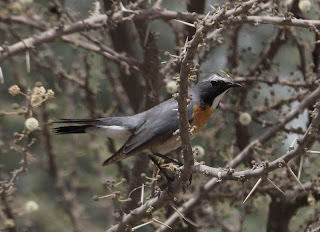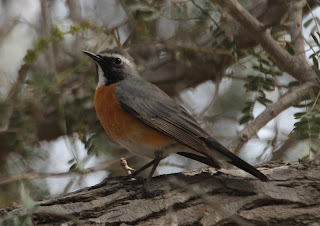It is Sunday and nearly 13.30 hrs. I am in the disabled washroom at ADCO HQ! Why do you ask? As those of you who know me, know, I am not disabled (well physically at least). Long experience of changing from business suit, to birding clothes, has taught me always to use the disabled bathroom. More space, that nice shelf at waist height to put all your stuff on. There are towels & soap. It's great! I look at my watch, it is time to go. Today it is the death run up to Dubai. The Dubai birders have in the last week enjoyed an orgy of crake watching: first a Baillon's, then a Spotted and finally a Corncrake. It is the latter species that I need, the fabled Crex crex of my youth. When I started birding in 1962, this species had just vanished from its former haunts. I grew up hearing older birders recount in graphic detail their Corncrake sightings - but for me nothing! I was in my teens before my first sighting. It has always held a special appeal for me.
I drive, Neil phones, he will meet me at Safa Park. Then I receive a welcome call from Khalifa, the bird is still there! My foot subconciously presses harder to the floor. Neil takes me straight to the spot, but before we get there, he says "is that a Common Swift up there?" It is indeed and what's more it has a friend. In truth there could have been more but we press on. Within seconds we find the Corncrake creeping around the base of the hedge. I smile.
I drive home happy. Two very good species added to the tally.
As a little postscript to this tale, Jacky Judas from Al Ain, drove to see this Corncrake the next evening. He saw it and was very pleased with his efforts. However, the very next day, while birding before work, a Corncrake ran across the road in front of him! Such is life!
2 species added (284 species total): 360 kms travelled.
It is Monday, the last day of April. I skip out to Saadiyat Golf Course in the vain hope of adding yet more migrants to my list. It is the first really hot day of the year and it is slow going. 3 European Rollers; Lesser Grey Shrike; 6 Common Redstarts were the pick of the crop. A pair of Red wattled Lapwing have produced at least one chick.
I drive, Neil phones, he will meet me at Safa Park. Then I receive a welcome call from Khalifa, the bird is still there! My foot subconciously presses harder to the floor. Neil takes me straight to the spot, but before we get there, he says "is that a Common Swift up there?" It is indeed and what's more it has a friend. In truth there could have been more but we press on. Within seconds we find the Corncrake creeping around the base of the hedge. I smile.
Corncrake
Crex crex
We look for the Wood Warbler that Neil saw the other day, but a few Common Redstarts, a Red backed Shrike and a lone Willow Warbler are all that we can find. I press on to Mushrif Park in the hope of a Eurasian Honey Buzzard. I stand on the hill, scanning, a pair of Shikra start to display. Then a pernis breaks the skyline. My hopes soar, but it turns out to be an Oriental Honey Buzzard.
Oriental Honey Buzzard
I drive home happy. Two very good species added to the tally.
As a little postscript to this tale, Jacky Judas from Al Ain, drove to see this Corncrake the next evening. He saw it and was very pleased with his efforts. However, the very next day, while birding before work, a Corncrake ran across the road in front of him! Such is life!
2 species added (284 species total): 360 kms travelled.
It is Monday, the last day of April. I skip out to Saadiyat Golf Course in the vain hope of adding yet more migrants to my list. It is the first really hot day of the year and it is slow going. 3 European Rollers; Lesser Grey Shrike; 6 Common Redstarts were the pick of the crop. A pair of Red wattled Lapwing have produced at least one chick.
Red wattled Lapwing
0 species added (284 species total): 120 kms travelled. 
















































